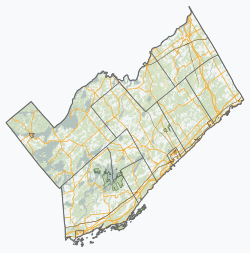Brockville | |
|---|---|
| City of Brockville | |
From left to right: John H. Fulford Memorial Fountain, Brockville skyline, Brockville Court House, Downtown Brockville | |
| Nickname: "City of 1000 Islands" | |
| Motto(s): Industria, Intelligentia, Prosperitas (Latin) "Industry, Intelligence, Prosperity" | |
| Coordinates: 44°35′N 75°41′W / 44.583°N 75.683°W | |
| Country | Canada |
| Province | Ontario |
| County | Leeds and Grenville (independent) |
| Settled | 1785 |
| Incorporated | 1832 |
| Government | |
| • Type | City |
| • Mayor | Matt Wren |
| • Federal riding | Leeds—Grenville—Thousand Islands and Rideau Lakes |
| • Provincial riding | Leeds—Grenville—Thousand Islands and Rideau Lakes |
| Area | |
| • Land | 20.91 km2 (8.07 sq mi) |
| • Metro | 576.87 km2 (222.73 sq mi) |
| Population | |
| • City (single-tier) | 22,116 |
| • Density | 1,057.8/km2 (2,740/sq mi) |
| • Metro | 31,661 |
| • Metro density | 54.9/km2 (142/sq mi) |
| Time zone | UTC−05:00 (EST) |
| • Summer (DST) | UTC−04:00 (EDT) |
| Postal code FSA | K6T to K6V |
| Area code(s) | 613, 343 |
| Website | www.brockville.com |
Brockville, formerly Elizabethtown, is a city in Eastern Ontario, Canada, in the Thousand Islands region. Although it is the seat of the United Counties of Leeds and Grenville, it is politically independent of the county. It is included with Leeds and Grenville for census purposes only.
Known as the "City of the 1000 Islands", Brockville is located on the north shore of the Saint Lawrence River, about halfway between Kingston to the west and Cornwall to the east. It is 115 km (71 mi) south of the national capital Ottawa. Brockville faces the village of Morristown, New York, on the south side of the river.
Brockville is situated on the land which was previously inhabited by the St. Lawrence Iroquoians[3] and later by the Oswegatchie people.[4] Brockville is one of Ontario's oldest communities established by Loyalist settlers and is named after the British general Sir Isaac Brock.
Tourist attractions in Brockville include the Brockville Tunnel, Fulford Place, and the Aquatarium.
- ^ a b "Brockville census profile". 2021 Census of Population. Statistics Canada. Retrieved March 25, 2023.
- ^ a b "Brockville [Census Agglomeration]". Statistics Canada. Retrieved March 25, 2023.
- ^ Trigger, Bruce G. (1979). "Sixteenth century Ontario: history, ethnohistory and archaeology". Ontario History. 71 (4): 205–223.
In 1535, a number of Iroquoian villages totalling several thousand people, were recorded by Jacques Cartier in the vicinity of Quebec City and on Montreal Island. More St. Lawrence Iroquoian villages had been located farther upriver in the Summerstown and Brockville areas and south of the river in Jefferson County, New York, in prehistoric times. Of these, at least the Brockville area was still inhabited in the protohistoric times.
- ^ Surtees, R. J. (February 1984). Indian Land Surrenders in Ontario 1763-1867 (PDF). Indian and Northern Affairs Canada. pp. 25–34. Archived (PDF) from the original on October 20, 2020. Retrieved June 5, 2021.






